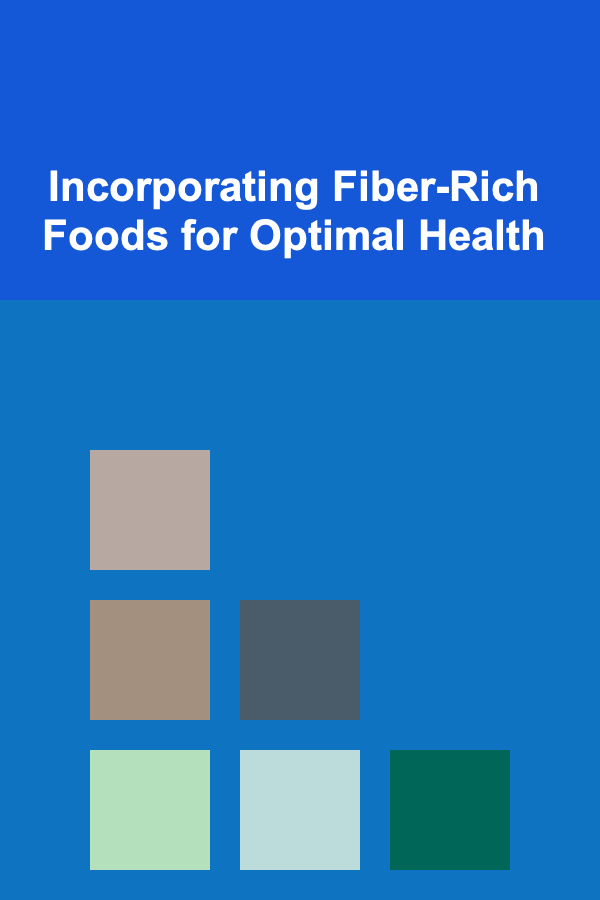
Incorporating Fiber-Rich Foods for Optimal Health
ebook include PDF & Audio bundle (Micro Guide)
$12.99$7.99
Limited Time Offer! Order within the next:

In the realm of nutrition, fiber often takes a backseat to macronutrients like protein and carbohydrates. However, fiber plays a crucial role in maintaining overall health and well-being. From promoting digestive regularity to reducing the risk of chronic diseases, the benefits of a fiber-rich diet are extensive and well-documented. This comprehensive guide explores the importance of fiber, the different types of fiber, the numerous health benefits, practical strategies for incorporating fiber-rich foods into your diet, and potential considerations to keep in mind.
Understanding Fiber: A Foundation for Health
Fiber, also known as roughage or bulk, is a type of carbohydrate that the body cannot digest. Unlike other carbohydrates, fiber passes relatively intact through the digestive system, contributing to various physiological processes. There are two primary types of fiber: soluble and insoluble.
Soluble Fiber: Dissolving into Health
Soluble fiber dissolves in water, forming a gel-like substance in the digestive tract. This gel slows down digestion, which can help regulate blood sugar levels and lower cholesterol. Excellent sources of soluble fiber include:
- Oats: Oatmeal, oat bran, and oat flour are versatile options for breakfast and baking.
- Beans and Legumes: Kidney beans, black beans, lentils, chickpeas, and peas are packed with soluble fiber.
- Fruits: Apples, citrus fruits (oranges, grapefruit), pears, and berries are good sources.
- Psyllium Husk: A commonly used fiber supplement derived from the seeds of the Plantago ovata plant.
- Flaxseeds: Ground flaxseeds can be added to smoothies, yogurt, or baked goods.
Insoluble Fiber: The Digestive Powerhouse
Insoluble fiber does not dissolve in water and adds bulk to the stool, facilitating the movement of waste through the digestive system. This helps prevent constipation and promotes bowel regularity. Rich sources of insoluble fiber include:
- Whole Wheat Products: Whole wheat bread, pasta, and cereals. Look for products where whole wheat is the first ingredient.
- Wheat Bran: A byproduct of wheat milling, wheat bran is an excellent source of insoluble fiber.
- Vegetables: Broccoli, cauliflower, leafy green vegetables (spinach, kale), and celery.
- Nuts and Seeds: Almonds, walnuts, sunflower seeds, and pumpkin seeds.
- Fruit Skins: Leaving the skin on apples, pears, and other fruits increases their fiber content.
The Extensive Health Benefits of Fiber
Consuming an adequate amount of fiber is associated with a wide range of health benefits, impacting various aspects of physical well-being.
Digestive Health: The Cornerstone of Well-being
Perhaps the most well-known benefit of fiber is its role in promoting digestive health. Fiber adds bulk to the stool, which helps prevent constipation and promotes regular bowel movements. Insoluble fiber, in particular, is effective in this regard. By easing the passage of waste through the digestive system, fiber also reduces the risk of diverticulitis (inflammation of pouches in the colon) and hemorrhoids.
Weight Management: A Feeling of Fullness
Fiber can play a significant role in weight management. High-fiber foods tend to be more filling than low-fiber foods, helping to control appetite and reduce overall calorie intake. Soluble fiber, in particular, slows down digestion, leading to a prolonged feeling of fullness and satiety. This can be beneficial for individuals trying to lose weight or maintain a healthy weight.
Blood Sugar Control: A Stabilizing Influence
Soluble fiber can help regulate blood sugar levels by slowing down the absorption of glucose (sugar) from food. This is particularly important for individuals with diabetes or insulin resistance. By preventing rapid spikes in blood sugar, fiber can help improve glycemic control and reduce the risk of complications associated with diabetes.
Cholesterol Reduction: A Heart-Healthy Choice
Soluble fiber can help lower LDL ("bad") cholesterol levels by binding to cholesterol in the digestive tract and preventing its absorption into the bloodstream. This can reduce the risk of heart disease, stroke, and other cardiovascular problems. Studies have shown that increasing fiber intake can lead to a modest but significant reduction in LDL cholesterol.
Reduced Risk of Chronic Diseases: A Protective Shield
Numerous studies have linked a high-fiber diet to a reduced risk of several chronic diseases, including:
- Type 2 Diabetes: Fiber helps regulate blood sugar levels and improve insulin sensitivity.
- Heart Disease: Fiber lowers LDL cholesterol and blood pressure, reducing the risk of cardiovascular events.
- Certain Cancers: Some studies suggest that a high-fiber diet may protect against colon cancer and other types of cancer.
- Diverticulitis: Fiber prevents constipation and promotes regular bowel movements, reducing the risk of diverticulitis.
Gut Microbiome Health: Feeding the Good Bacteria
Fiber serves as a prebiotic, meaning it provides nourishment for the beneficial bacteria in the gut. These bacteria play a crucial role in digestion, immunity, and overall health. A healthy gut microbiome is associated with a reduced risk of inflammation, improved nutrient absorption, and a stronger immune system. Different types of fiber promote the growth of different types of beneficial bacteria, highlighting the importance of consuming a variety of fiber-rich foods.
Practical Strategies for Incorporating Fiber-Rich Foods
Making gradual changes to your diet is the key to successfully incorporating more fiber-rich foods. Here are some practical strategies to help you increase your fiber intake:
Start Slowly and Gradually Increase Intake
Adding too much fiber too quickly can lead to digestive discomfort, such as gas, bloating, and cramping. It's important to start slowly and gradually increase your fiber intake over a period of several weeks. This allows your digestive system to adjust and reduces the likelihood of unpleasant side effects. A good starting point is to add one or two servings of fiber-rich foods to your diet each day and gradually increase from there.
Read Food Labels Carefully
Pay attention to the nutrition facts labels on packaged foods. Look for products that are high in fiber (at least 3-5 grams per serving). Check the ingredient list to ensure that whole grains are listed as the first ingredient. Be wary of products that claim to be "high in fiber" but contain a significant amount of added sugar or unhealthy fats.
Choose Whole Grains Over Refined Grains
Replace refined grains, such as white bread, white rice, and processed cereals, with whole grain options, such as whole wheat bread, brown rice, quinoa, and oatmeal. Whole grains contain the entire grain kernel, including the bran, germ, and endosperm, which are all rich in fiber and nutrients. Refined grains have had the bran and germ removed, stripping away much of the fiber and nutritional value.
Add Beans and Legumes to Your Meals
Beans and legumes are excellent sources of fiber, protein, and other essential nutrients. Add them to soups, salads, stews, chili, and other dishes. You can also use them as a meat substitute in vegetarian or vegan meals. Consider using canned beans for convenience, but rinse them thoroughly to remove excess sodium.
Eat More Fruits and Vegetables
Fruits and vegetables are naturally rich in fiber, vitamins, and minerals. Aim to eat at least five servings of fruits and vegetables each day. Choose a variety of different colors and types to ensure you are getting a wide range of nutrients. Remember to eat the skins of fruits and vegetables whenever possible, as they often contain a significant amount of fiber.
Snack on Nuts and Seeds
Nuts and seeds are a healthy and convenient snack option that is also rich in fiber. Choose unsalted nuts and seeds to avoid excess sodium. Portion control is important, as nuts and seeds are also high in calories. A small handful (about 1/4 cup) is a good serving size.
Start Your Day with a High-Fiber Breakfast
A high-fiber breakfast can help keep you feeling full and energized throughout the morning. Choose options such as oatmeal with berries and nuts, whole wheat toast with avocado, or a high-fiber cereal. Avoid sugary cereals and processed breakfast foods, which are often low in fiber and high in added sugar.
Blend Fiber into Smoothies
Smoothies are a great way to sneak extra fiber into your diet. Add ingredients like spinach, kale, flaxseeds, chia seeds, or berries to your smoothie for a fiber boost. Be mindful of the other ingredients you add, as smoothies can quickly become high in sugar and calories.
Use Fiber Supplements with Caution
While it's always best to get your fiber from whole foods, fiber supplements can be a helpful option for individuals who struggle to meet their daily fiber needs through diet alone. Psyllium husk is a commonly used fiber supplement that can be added to water, juice, or smoothies. However, it's important to use fiber supplements with caution and to follow the instructions on the label. Drink plenty of water when taking fiber supplements to avoid constipation. It's also advisable to consult with a healthcare professional before taking fiber supplements, especially if you have any underlying health conditions.
Hydrate Adequately
Drinking plenty of water is essential for optimal digestive health, especially when increasing your fiber intake. Fiber absorbs water, so if you don't drink enough fluids, you may experience constipation. Aim to drink at least eight glasses of water per day, and increase your fluid intake as you increase your fiber intake.
Recommended Daily Fiber Intake
The recommended daily fiber intake varies depending on age, sex, and overall health. According to the Dietary Guidelines for Americans, adults should aim for the following daily fiber intake:
- Women: 25 grams
- Men: 38 grams
Most Americans fall short of these recommendations. By incorporating more fiber-rich foods into your diet, you can significantly improve your fiber intake and reap the numerous health benefits associated with a high-fiber diet.
Potential Considerations and Precautions
While fiber is generally beneficial for health, there are a few potential considerations and precautions to keep in mind:
Excessive Fiber Intake
Consuming too much fiber can lead to digestive discomfort, such as gas, bloating, and diarrhea. It's important to increase your fiber intake gradually and to drink plenty of water to avoid these side effects.
Nutrient Absorption
In some cases, very high fiber intake may interfere with the absorption of certain nutrients, such as iron, zinc, and calcium. However, this is typically only a concern for individuals with very high fiber intakes (significantly above the recommended daily allowance) or those with underlying health conditions that affect nutrient absorption.
Certain Medical Conditions
Individuals with certain medical conditions, such as inflammatory bowel disease (IBD) or irritable bowel syndrome (IBS), may need to adjust their fiber intake based on their individual tolerance and symptoms. It's advisable to consult with a healthcare professional or registered dietitian to determine the appropriate fiber intake for your specific needs.
Medication Interactions
Fiber can interfere with the absorption of certain medications. If you are taking any medications, it's important to talk to your doctor or pharmacist about potential interactions with fiber.
Conclusion: Embracing a Fiber-Rich Lifestyle
Incorporating fiber-rich foods into your diet is a simple yet powerful way to improve your overall health and well-being. From promoting digestive regularity to reducing the risk of chronic diseases, the benefits of a high-fiber diet are undeniable. By gradually increasing your fiber intake, choosing whole grains over refined grains, adding beans and legumes to your meals, and eating plenty of fruits and vegetables, you can reap the numerous rewards of a fiber-rich lifestyle. Remember to listen to your body, stay hydrated, and consult with a healthcare professional if you have any concerns or underlying health conditions. Embrace the power of fiber and embark on a journey towards a healthier and happier you.

Exploring Freelance Opportunities for Deep Learning and Passive Income
Read More
How to Choose the Right Travel Insurance
Read More
How to Handle Security Deposits and Avoid Legal Issues
Read More
How to Renovate Your Home for Better Flow and Functionality
Read More
How to Master Creating Geometric Patterns
Read More
How To Paint Abstract Art: Unleash Your Creativity
Read MoreOther Products

Exploring Freelance Opportunities for Deep Learning and Passive Income
Read More
How to Choose the Right Travel Insurance
Read More
How to Handle Security Deposits and Avoid Legal Issues
Read More
How to Renovate Your Home for Better Flow and Functionality
Read More
How to Master Creating Geometric Patterns
Read More